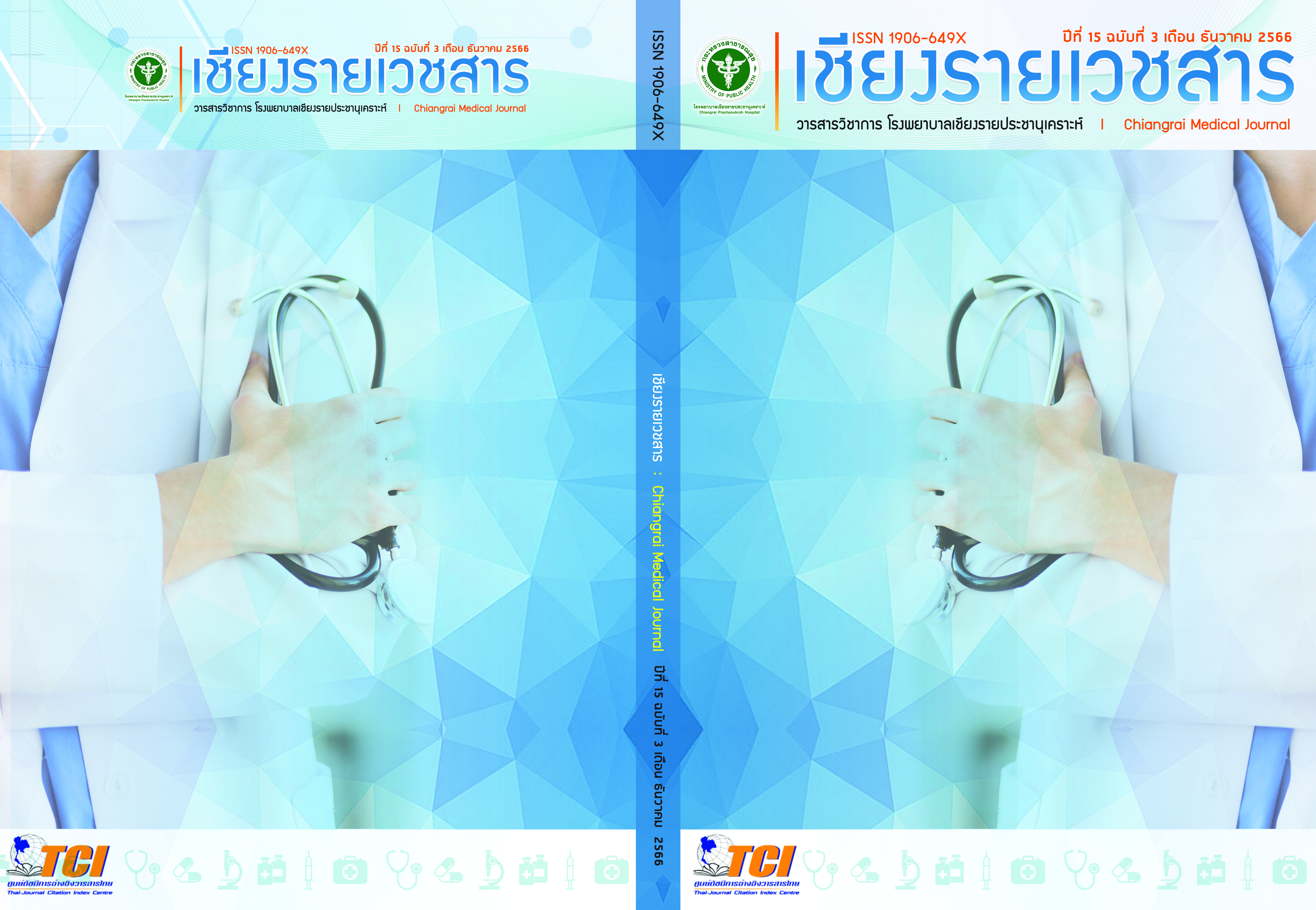ประสิทธิผลการดูแลประคับประคองในผู้ป่วยมะเร็งปอดระยะท้าย เปรียบเทียบกับการดูแลตามมาตรฐาน โรงพยาบาลเชียงรายประชานุเคราะห์
Main Article Content
บทคัดย่อ
ความเป็นมา : การดูแลประคับประคองมีประสิทธิภาพในการดูแลผู้ป่วยด้วยโรคที่คุกคามต่อชีวิต เพิ่มคุณภาพชีวิตให้แก่ผู้ป่วยและครอบครัว ลดค่ารักษาพยาบาล และเพิ่มความพึงพอใจในการรับบริการ โรงพยาบาลเชียงรายประชานุเคราะห์มีศูนย์ประคับประคองที่ดูแลผู้ป่วยกลุ่มโรคดังกล่าว แต่ยังไม่เคยมีการศึกษาด้านประสิทธิผล การศึกษานี้จะช่วยพัฒนาประสิทธิภาพการดำเนินงานและเพิ่มศักยภาพการดูแลผู้ป่วยของศูนย์ประคับประคองของโรงพยาบาล
วัตถุประสงค์: เพื่อศึกษาเปรียบเทียบประสิทธิผลการดูแลประคับประคองในผู้ป่วยมะเร็งปอดระยะท้ายเทียบกับการดูแลตามมาตรฐาน
วิธีการศึกษา : ศึกษาแบบ Retrospective cohort study ในผู้ป่วยมะเร็งปอดระยะท้ายที่รักษา ณ รพ.เชียงรายประชานุเคราะห์และเสียชีวิตปีงบประมาณ 2564 - 2565 จำนวน 214 ราย แบ่งเป็นกลุ่มประคับประคอง 170 รายและกลุ่มมาตรฐานที่เสียชีวิตในช่วงเดียวกันแต่ไม่ได้ดูแลประคับประคอง 44 ราย โดยเปรียบเทียบประสิทธิผลการดูแล ได้แก่ การประเมินอาการ ได้รับยา strong opioid ทำ family conference การเข้าICU เสียชีวิต ณ สถานที่ตามต้องการ และค่ารักษาพยาบาลครั้งสุดท้ายก่อนเสียชีวิต
ผลการศึกษา : กลุ่มประคับประคองได้ประเมินและจัดการอาการมากกว่ากลุ่มมาตรฐานอย่างมีนัยสำคัญทางสถิติ (p < 0.001) ได้รับยา strong opioid และทำ Family Conference เพื่อวางแผนการดูแลมากกว่า ทำ Invasive Procedure เช่น ใส่ท่อช่วยหายใจ ได้ Inotrope, CPR การเข้า ICU น้อยกว่ากลุ่มมาตรฐาน สถานที่เสียชีวิตของผู้ป่วยทั้งสองกลุ่มแตกต่างกันอย่างมีนัยสำคัญทางสถิติ ผู้ป่วยกลุ่มที่ได้รับการดูแลแบบประคับประคองส่วนใหญ่ (ร้อยละ 57.40) เสียชีวิตตรงตามสถานที่ที่ระบุไว้ ในขณะที่กลุ่มที่ได้รับการดูแลแบบมาตรฐานส่วนใหญ่ (ร้อยละ 84.09) ไม่ได้ตัดสินใจเรื่องสถานที่เสียชีวิต ด้านค่ารักษาพยาบาลช่วงท้ายของชีวิตในกลุ่มประคับประคองลดลง 9,005.94 บาทเมื่อเทียบกับกลุ่มมาตรฐาน
สรุปและข้อเสนอแนะ : การดูแลผู้ป่วยมะเร็งปอดระยะท้ายแบบประคับประคองเพิ่มประสิทธิผลในการประเมินและจัดการอาการด้วย strong opioid การวางแผนดูแลล่วงหน้า และการที่ผู้ป่วยได้เสียชีวิต ณ สถานที่ที่ต้องการ จึงควรประยุกต์ใช้รูปแบบการดูแลประคับประคองในผู้ป่วยกลุ่มนี้ให้มากยิ่งขึ้น
Article Details

อนุญาตภายใต้เงื่อนไข Creative Commons Attribution-NonCommercial-NoDerivatives 4.0 International License.
เอกสารอ้างอิง
who.int[internet]. Palliative care key fact;2020[update 2020 Aug 8; cited 2021 Nov 16] Available from: https://www.who.int/news-room/fact-sheets/detail/palliative-care
Thapanakulsuk K, Saleekun S, Abhisitthiwasana N, Thiammok M. Advanced care planning for peaceful death. Journal of Boromarajonani College of Nursing. 2017;33(3):138-45.
Lertsanguansinchai P , Nuchprayoon I , Chatkaew P, Sitthiphan C, Editors. End of life care improving care of the dying. 2nd ed. Bangkok. Aksorn Samphan Printing House; 2007.
Nakwiroj K, editor. Handbook for end-of-life care and family. Nonthaburi: Beyond Enterprise; 2016.
World Health Organization [internet]. WHO Definition of palliative care. [update 2020 ; cited 2020 Oct 24]Available from:https://www.who.int/cancer/palliative/definition/en/.
National Cancer Prevention and Control Plan Committee. National Cancer Control Program National Cancer Control Program (2018-2022). Nonthaburi: Department of Medical Services Ministry of Public Health; 2018.
Department of Medical Services, Ministry of Public Health. Handbook of palliative and end-stage care (for medical personnel). Bangkok:Veterans Welfare Organization under the Royal Patronage; 2020.
Department of Medical Services, Ministry of Public Health. List disease of palliative care and functional unit. Bangkok: Art Qualified; 2016.
Board of Directors for the preparation of the 12th National Health Development Plan (2017-2021) Ministry of Public Health. Drafting the 12th National Health Development Plan (2017-2021) [internet].October 2016.[cited on 11 Oct. 2020] Available from: http://wops.moph.go.th/ops/oic/data/20161115144754_1_.pdf
Foundation of Thai Gerontology Research and Development Institute. Situation of the Thai elderly 2020. Nakhon Pathom: Institute for Population and Social Research. Mahidol University; 2021.
Imsamran V, Chaiweerawatana A, Thanasitthichai S, Laowahutanon P, Sangkrajang S, Supa-attakorn P, et al. Cancer. In Makornsarn C, editors. Thailand Medical Services Profile 2011-2014. Nonthaburi: Department of Medical Services, Ministry of Public Health; 2014. p.5-21.
Annual report, Medical information center, Chiangraiprachanukroh hospital , Fiscal year 2021-2022
Elsayem A, Swint K, Fisch MJ, Palmer JL, Reddy S, Walker P, et al. Palliative care inpatient service in a comprehensive cancer center: clinical and financial outcomes. J Clin Oncol. 2004;22(10):2008-14.
Nevadunsky NS, Gordon S, Spoozak L, Van Arsdale A, Hou Y, Klobocista M, et al. The role and timing of palliative medicine consultation for women with gynecologic malignancies: association with end of life interventions and direct hospital costs. Gynecol Oncol. 2014;132(1):3-7.
Smith TJ, Coyne P, Cassel B, Penberthy L, Hopson A, Hager MA. A high-volume specialist palliative care unit and team may reduce in-hospital end-of-life care costs. J Palliat Med. 2003;6(5):699-705.
Morrison RS, Dietrich J, Ladwig S, Quill T, Sacco J, Tangeman J, et al. Palliative care consultation teams cut hospital costs for Medicaid beneficiaries. Health Aff (Millwood). 2011;30(3):454-63.
Morrison RS, Penrod JD, Cassel JB, Caust-Ellenbogen M, Litke A, Spragens L, et al. Cost savings associated with US hospital palliative care consultation programs. Arch Intern Med. 2008;168(16):1783-90.
Sinsuwan W, Pairojkul S, Gomutbutra P, Kongkum K, Kosuwon W. A Retrospective, single center, observational study, comparing the direct cost of end-of-life care patients with advanced cancer care: palliative care versus usual uare. J Palliat Care Med 2016;6:243.
Macmillan PJ, Chalfin B, Soleimani Fard A, Hughes S. Earlier palliative care referrals associated with reduced length of stay and hospital charges. J Palliat Med. 2020;23(1):107-11.
Brumley R, Enguidanos S, Jamison P, Seitz R, Morgenstern N, Saito S, et al. Increased satisfaction with care and lower costs: results of a randomized trial of in-home palliative care. J Am Geriatr Soc. 2007;55(7):993-1000.
Temel JS, Greer JA, Muzikansky A, Gallagher ER, Admane S, Jackson VA, et al. Early palliative care for patients with metastatic non-small-cell lung cancer. N Engl J Med. 2010;363(8):733-42.
Penrod JD, Deb P, Luhrs C, Dellenbaugh C, Zhu CW, Hochman T, et al. Cost and utilization outcomes of patients receiving hospital-based palliative care consultation. J Palliat Med. 2006;9(4):855-60.
Bar-Sela G, Tur-Sinai A, Givon-Schaham N, Bentur N. Advance care planning and attainment of cancer patients' end-of-life preferences: relatives' perspective. Am J Hosp Palliat Care. 2023;40(3):322-8.
Phupradabkrit Y. [Internet]. A good death : a right that everyone should receive with practical problem.2023 [Cited 2023 Sep 8]Available from: https://www.krisdika.go.th/data/activity/act13459.pdf
Working Group on Developing Guidelines for Creating an Advance Care Plan for Thailand. Thai standards for advance care planning B.E. 2022 [Internet]. Nonthaburi: The National Health Commission Office; 2022 [updated February; cited 2023 October 9]. Available from: https://peacefuldeath.co/wp-content/uploads/2022/03/ Thai standards for advance care planning B.E. 2022


